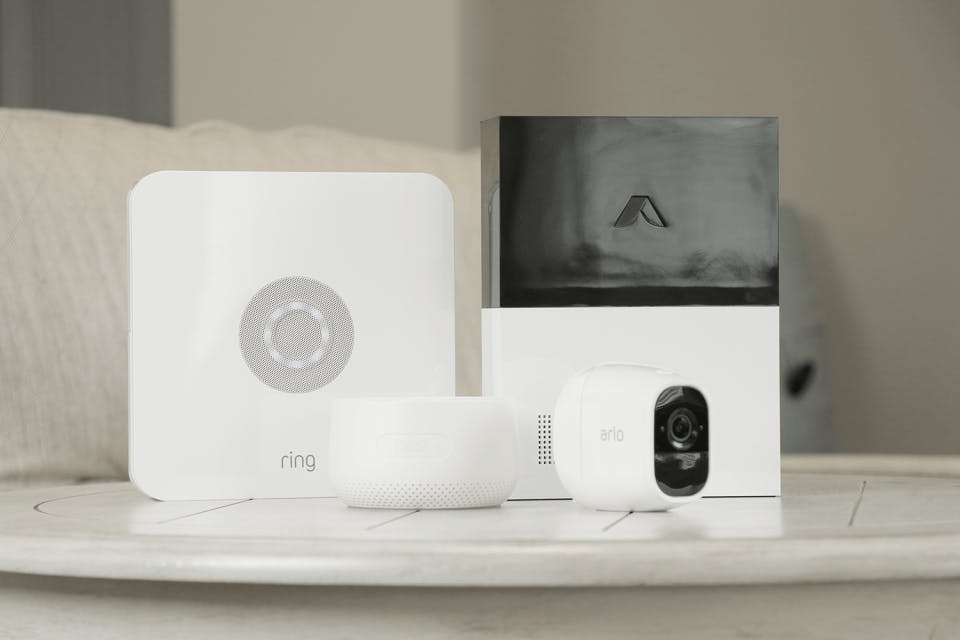
Home alarm systems can be monitored or unmonitored. With monitored security systems, you typically sign a contract and pay a monthly fee to have someone watch your back 24/7. With self-monitored or unmonitored home security, you’re responsible for calling for help should the need arise. There is also do-it-yourself (DIY) home security, referring to monitored systems which are self-installed, and no contract systems which provide monitoring without a contract.
There are pros and cons to all four approaches. However, if you’re here, we assume you’ve decided to go the self-monitored route.
Why You Should Trust Us
We’ve tested multiple self-monitored systems including abode, eTiger, Scout, iSmartAlarm, SimpliSafe, SmartThings (v1, v2, and v3), Piper, Armorax, SkyLink, Oplink, GetSafe, Ring Alarm, Nest Secure, and dozens of security cameras.
Our testers have attended multiple Consumer Electronic Shows as well as other trade shows where we’ve had hands-on experience with self-monitored systems such as Honeywell Smart Home Security, Angee, MyFox, Insteon, Oomi, and many more.
What To Look For in a Self-Monitored Security System

Simplisafe is currently running one of the best promotions we've seen. Check their website for full details.
Self-monitored home security is relatively new and the technology still young. Companies like SimpliSafe have been in the game for a while, but there is an explosion of new companies offering self-monitored alarm systems through the smart home market. With all the new choices, picking one can be a challenge. In general, you should look for a system that can communicate with multiple people in multiple ways while allowing you control and providing protection beyond burglaries.
Communication
If you plan to self-monitor your alarm, you are solely responsible for responding to any emergencies. From a communication perspective, it’s important that a self-monitored system can:
- Send push or text notifications.
- Call you if your system is breached.
- Notify designated contacts, like friends or family members.
Control
Although communication is the most important feature, the ability to self-service the alarm is also important. Look for things like:
- The ability to arm and disarm a system remotely
- Full control over system customization
- Full control over modes like home, away, vacation, and sleep
Protection Beyond Burglaries
A self-monitored system should be smart. It should have the ability to follow rules with cause-and-effect relationships between different devices. For example, if carbon monoxide is detected, you can create a rule to turn your heating system off. Or you can create another rule that says if the front door is open, your security camera should automatically start recording footage. In doing so, it can potentially protect your home from flooding, fire, or even rapidly changing temperatures.
Visual Verification
Finally, you will want to add a security camera to your system if you choose to self-monitor. Trust us, there is nothing more frustrating (and potentially scary) than receiving an alert when you’re miles away with no way to know if the event is serious or not.
abode vs. SmartThings vs. Arlo Pro vs. iSmartAlarm vs. Ring Alarm vs. Nest Secure Home Security
 |  |  |  |  |  | |
| Base Pricing | $199.00 | $67.94 | $329.00 | $135.51 | $399.99 | $199.00 |
| Monthly Fee | $0+ | $0+ | $0+ | $0+ | $0+ | $0+ |
| Push or Text Notifications | ||||||
| Phone Call Notifications | Via IFTTT | Via IFTTT | Via IFTTT | |||
| Alert Friends and Family | ||||||
| Remote Arm and Disarm | ||||||
| Power Failure Redundancy | Battery Backup | Cameras Have Battery Backup, Base Station Requires Power, Solar Charging Panel | Must Add UPS* | Battery Backup | Battery Backup | |
 |  |  |  |  |  | |
| Internet Failure Redundancy | Cellular Starting at $10.00/month | NA, but some SmartApps can work locally. | NA | NA | Cellular Starting at $5.00/month | Cellular Starting at $10.00/month |
| Motion Sensors | 1 Included | $24.99 | via SmartThings | 1 Included | Integrated in Door/Window Sensors | 1 Included |
| Door/Window Sensors | 1 Included | $19.95 | via SmartThings | 2 Included | 2 Included | 1 Included |
| Siren | Included | $49.95 | Included | Included | Included | Included |
| Smoke / Fire / Heat | $45 | $27.84 | via SmartThings | Detect Smoke and CO Alarms with Spot $99.99 | $119 | Works with First Alert |
| Video Surveillance | $149+ | $159.99+ | Included | $99.99+ | $199+ | $99.99+ |
| iTunes App Rating | 4 | 3.8 | 4 | 3 | 2.6 | 3 |
| Google Play Rating | 4.5 | 4 | 4 | 3.2 | 4 | 3.6 |
| IFTTT | ||||||
| Other Home Automation | Z-Wave, Zigbee, Amazon Echo, Works with Nest, ecobee, Hue, LIFX, Google Assistant, CUE, Danalock V3, HomeKit (Coming Soon) | Z-Wave, Zigbee, Amazon Echo, Stringify, Amazon Echo, Google Assistant, and More | SmartThings | iSmart Smart Plug, Amazon Echo | Works with Nest and Google Home, Built-In Google Assistant | Z-Wave (smart locks from Yale, Schlage, etc.), Zigbee, Amazon Echo, Danalock, August Smart Lock Pro |
| Professional Monitoring | Starting at $20.00/month | Through Scout’s Service | Through Scout via SmartThings | NA | $19.99/month with a contract, $29.99 without a contract | $10.00/month |
| Where to Buy | Buy Here | Buy Here | Buy Here | Buy Here | Buy Here | Buy Here |
 |  |  |  |  |  |
*In addition to using a UPS, the Satellite Siren is a nifty way to make sure iSmart continues to protect during power outages. It uses three AAA batteries to keep the Satellite running even if power is cut.
The Three Best Self-Monitored Alarm Systems
1. Most Comprehensive: abode
2. Easiest to Use: Ring
3. Camera Based Approach: Arlo
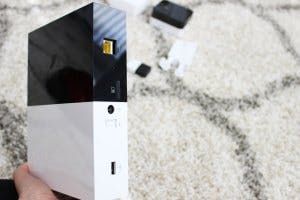
abode
abode is a self-monitored home security system that ships with everything you need to protect your home while also providing access to several smart home features for free. In many ways, it is what Scout once was.
The abode Gateway includes battery backup and a cellular chip which you can activate for $8.00 per month. Of course, you don’t have to do that; you can use the system for free. For free you get smartphone notifications, email alerts, an IFTTT integration, integration with Amazon Alexa (Echo, Dot, etc.), Google Assistant (Home, Mini, Max, etc.), Works with Nest, HomeKit (coming soon), and the ability to arm and disarm your system from anywhere. If you don’t mind paying, abode also sells professional monitoring services for $20.00 per month.
As an alternative to the abode Gateway, you can use abode iota. iota shares many of the same features as the Gateway, but it’s an all-in-one camera and hub that you can use to protect your home on its own, or you can add other sensors. Just like the Gateway, iota supports Z-Wave, Zigbee, HomeKit (coming soon), and abode RF. You can learn more about abode iota here.
From the abode app, you can view your camera’s live feed, control features like geofencing, and you can swap between abode’s three modes: home, standby, and away. If you want to customize which sensors should trigger in the different modes, create quick actions, or manage notifications, you’ll need use to abode’s web portal—not the abode app.
Finally, abode has several security camera options. First, the initial purchase price includes an image sensor which abode calls the “Indoor Motion Sensor with Camera.” This device snaps three photos anytime it detects motion. If you want actual video footage, you will need to purchase one of their Indoor Streaming Cameras, or you can connect the system to your Nest Cam.
Pros
- Multiple Smart Home Integrations for Free
- Battery Backup and Optional Cellular Backup
- Professional Monitoring Available
- Native Geofencing Feature
Cons
- Clunky Hardware
- abode Camera Performance is not Impressive
- Base Station Requires Ethernet
- Web Portal More Robust Than Mobile App
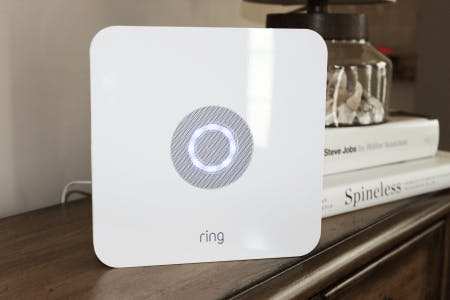
Ring Alarm
Ring replaced iSmartAlam as the “easiest to use.” It rivals iSmart’s inexpensive price while offering so much more like battery backup, cellular backup, professional monitoring, and better security. Ring Alarm is the first system to use a combination of Z-Wave Security 2 (S2) and Z-Wave SmartStart technologies to encrypt the signal between servers and hub as well as sensors and hub.
The system starts with the Ring Base Station which includes a siren. If you choose to pay for monitoring the system ($10/month), the siren will sound, the system will alert the monitoring center, and you will receive a push notification and an email if an alarm event occurs. With self-monitoring, however, you will only receive a push notification and email alert.
The Base Station connects to other sensors using Z-Wave Plus. Right now, it doesn’t connect to many Z-Wave devices, but it does connect to the First Alert Smoke/CO alarm and select Z-Wave locks including those made by Yale and Schlage. It also works with smart locks like Danalock and August. We're sure more integrations will come soon. Beyond that, you can also arm and disarm the system using your voice and an Amazon Alexa device. The system also ties into Alexa Guard which allows your Alexa-enabled device to notify Ring’s monitoring center if it hears anything unusual (glass breaking, smoke alarm, CO alarm) while you’re away from home.
Ring also has a fairly robust line of cameras including video doorbells and outdoor cameras. Using the included mobile app, you can manage your Ring cameras and your Ring Alarm. They also somewhat play together. You can set your cameras to record if there is an alarm event, but you can’t set your cameras to trigger an alarm event.
If you want to take a break from self-monitoring, Ring has a very affordable professional monitoring plan. For just $10 per month, you can add cellular monitoring, professional monitoring, as well as 60 days of cloud storage for all of your Ring cameras, which is a great deal.
Pros
- Easy to Use/Works Out of the Box
- Inexpensive Hardware
- S2 and Z-Wave SmartStart
Cons
- Cameras Are Not Our Favorite
- Limited Third-Party Integrations
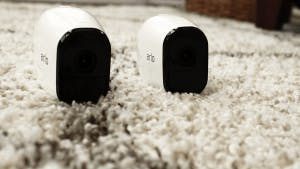
Arlo Pro and Pro 2
Arlo Pro is a home security camera system. The cameras are wire-free, powered by battery, and controlled by a hub which is dependent upon both power and internet. Arlo Pro has additional home security potential when connected to other Arlo products and SmartThings.
SmartThings supports Arlo Pro, Arlo Pro 2, the Pro Base Station, Arlo Q, and Arlo Q Plus. If your camera detects motion or sound, you can trigger a video clip or a SmartThings automation. This sequence of events also works in reverse. For example, if someone opens your front door when your SmartThings system is set to “away,” you can record a clip and sound your Arlo siren (which happens to be the loudest of the three sirens). Or, if Arlo Pro detects a sound, you can have your lights set to turn on. Unfortunately, the integration with SmartThings still has bugs and not everything works as it should; however, the potential is still there.
Of course, you don’t have to connect to SmartThings to gain security value from Arlo Pro. Alone, the system can monitor for activity both inside and outside. It also integrates with IFTTT. Like abode, Arlo natively supports geofencing. It will arm and disarm itself as you come and go. You can also create schedules for it to follow or manually swap between modes. The modes are completely customizable, including the ability to include or exclude cameras. You can even create custom modes.
If you want full coverage, you can add other Arlo cameras and devices to your home. There’s the Arlo Q wired indoor camera, Arlo Baby monitor, and even a line of smart lights. The Arlo Security Light is a battery-powered, weatherproof floodlight. It’s equipped with a motion sensor that can trigger the light or you can control it using your smartphone. From the app, you can turn it on or off and even change the color of the light, and if used with Arlo cameras, its motion sensor can trigger the camera to record. Finally, there’s the upcoming Arlo Audio Doorbell, which is a smart doorbell (audio only, no video) that lets you answer your door using the Arlo app. The Audio Doorbell pairs with Arlo cameras to provide front door video monitoring.
Pros
- Battery Powered Cameras
- Works Indoors and Outdoors
- Native Geofencing Feature
Cons
- False Alarms are More Common With Cameras
- SmartThings Integration is Buggy
Other Options
 |  |  |  | |
| Base Pricing | $67.94 | $215.00 | $120.00 | $234 |
| Monthly Fee | $0+ | $0+ | $0+ | $0+ |
| Push or Text Notifications | Starting at $9.99/month | Starting at $14.99/month | ||
| Phone Call Notifications | Via IFTTT | Via IFTTT (Starting at $9.99/month) | Starting at $14.99/month | |
| Alert Friends and Family | Starting at $9.99/month | Starting at $14.99/month | ||
| Remote Arm and Disarm | Starting at $9.99/month | Starting at $24.99/month | ||
| Power Failure Redundancy | Battery Backup | Battery Backup | Battery Backup | |
| Internet Failure Redundancy | NA, but some SmartApps can work locally. | NA | Cellular Starting at $9.99/month | Cellular Starting at $14.99/month |
| Motion Sensors | $24.99 | Included | $30.00 | Included |
| Door/Window Sensors | $19.99 | $49.95 | $20.00 | Included |
| Siren | $49.95 | Included | 1 Included | Included |
| Smoke / Fire / Heat | $99 | Temperature Sensor Included | NA | $29.99 |
| Video Surveillance | $159.99+ | Included | Works with Nest Cam | $99+ |
| iTunes App Rating | 3.8 | 1.5 | 3 | 1.5 |
| Google Play Rating | 4 | 3.5 | 4 | 3.4 |
| IFTTT | Starting at $9.99/month | |||
| Other Home Automation | Z-Wave, Zigbee, Amazon Echo, Stringify, Amazon Echo, Google Home, and More | Limited Z-Wave | Starting at $9.99/month – Integration with Amazon Echo, Works with Nest, and more | Starting at $24.99/month – Works With Nest, August Smart Locks |
| Professional Monitoring | Through Scout’s Service | NA | Starting at $19.99/month | Starting at $14.99/month |
| Where to Buy | Buy Here | Buy Here | Buy Here | Buy Here |
 |  |  |  |
Nest Secure
We're putting Nest at the top of the “Other Options” list intentionally. While it may not be great enough to nudge abode or Ring off of the list, we still give the system an overall thumbs up. What keeps it from the list above is that it’s expensive and lacks sensors. The kit ships with the Guard which is a base station and a keypad, two contact sensors which can double as motion sensors, two Tags which act as RFID tags, and you can add a range extender. That’s it. There’s no dedicated motion sensor, glass break sensor, flood sensor, freeze sensor, humidity sensor, etc.
Where Nest is slightly better than Ring is that the Nest cameras integrate well with the system. Nest sells several indoor and outdoor cameras as well as a video doorbell. If your Nest Secure detects an alarm event, it will trigger your camera to take a snapshot of the event. Second, Nest Secure has a better overall design with sleeker, more discreet sensors.
If you self-monitor, Nest Guard will connect to all of your sensors, send notification of events (push and email), and allow you to integrate with other Nest products. You can activate Guard’s cellular chip for $5 per month or even pay to add professional monitoring.
Finally, Nest Secure Works With Nest. It plays well with Philips Hue lights, Nest Protect, and more.
iSmartAlarm
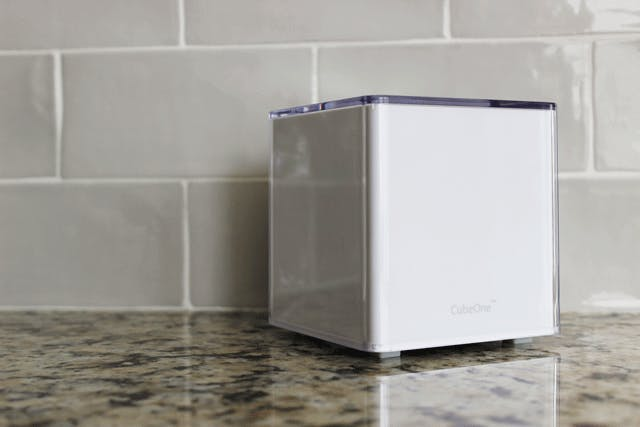
iSmart has sat on our recommended list for around four years, but we're now on the fence. In July of 2018, experts discovered that the system had several vulnerabilities. Some vulnerabilities have already been resolved via past updates and changes, but as far as we know, some are still in progress. We say “as far as we know” because iSmart was very hush hush about the issue, and that, our friends, is our biggest gripe. We feel like companies need to be open and honest about issues, and at the very least update existing customers. iSmart did not.
iSmart is simple. It isn’t as expandable as abode nor as stable as it lacks a cellular chip and battery backup, but it’s easy to install and use. Out of the box, you will have everything you need to protect your home. The iSmartAlarm starter kit includes a siren, two door/window sensors, a motion detector, two key fobs, and access to their mobile app.
The iSmart app is also easy to use. Open the app up, and you’re presented with giant buttons to arm the system, disarm it, swap to home mode, or trigger a panic alarm. Scroll down, and you will also find a sleep mode. Plus, thanks to a recent update, modes are customizable. You can modify modes including deciding which devices should trigger an alarm and which should not. You can also customize notifications and the system’s siren.
iSmart also provides phone call alerts natively. Of course, you can setup phone call alerts for abode and Arlo via IFTTT, but Ring and Nest are both waiting on IFTTT and even still, using IFTTT isn’t as reliable as a native feature. That said, iSmartAlarm works with IFTTT too. Through IFTTT, you can connect iSmart to other popular home automation devices like SmartThings, WeMo, Ring Doorbells, Nest, Philips Hue, and more. If you don’t want to expand into home automation through IFTTT, you can add a smart plug to the iSmart system. The smart plug can be used to automate small appliances and lamps. Finally, iSmart has its own Amazon Alexa skill. Using the skill, you can arm the system, disarm it, or swap modes with your voice.
iSmart also offers multiple camera options. We’ve tested KEEP and SPOT (both iSmart cameras), and we're not a fan. However, they sell two other cameras we have not tested including Spot+ and the iCamera KEEP Pro.
Pros
- Easy to Use/Works Out of the Box
- Completely Free
- Native Phone Call Alerts
Cons
- App is Slow
- Not as Expandable as Other Options
- Cameras are Low Quality
Honeywell Smart Home Security System
The Honeywell Smart Home Security System is not yet available so we can’t recommend it though it’s expected to hit the market soon. We did get a hands-on look at the device during CES 2018, and it does look like they’re on track to deliver a solid product.
Honeywell’s DIY security system relies on a device called the Camera Base Station. It’s an Amazon Echo-like device with a camera on top. It serves as the brains of the system, connecting with sensors and third party-devices via Z-Wave and controlling them using the app or voice control.
The Camera Base Station comes with its own AI voice assistant that can control the system with or without an internet connection. Also, it can access Amazon Alexa, Google Assistant, and Siri (via HomeKit).
The camera also boasts intelligent features such as facial recognition, motion detection with area masking, and sound detection.
Finally, the system will work with Honeywell’s Lyric product line, IFTTT, and HomeKit.
Scout Alarm
Scout, SimpliSafe, Nest Secure, Ring Alarm, and SmartThings are all no contract security systems. You can compare Scout and SimpliSafe here.
However, as of December of 2015, we no longer recommend Scout as a self-monitored home security system. In the past, they offered many features for free. But now, they charge. A paid plan is now required for:
- Push notifications
- Text message alerts
- Email alerts
- Phone call alerts
- Access to Scout’s web portal and mobile apps
- Cellular backup
- 24/7 UL-certified professional monitoring (Always On+ only)
- Police dispatch capability (Always On+ only)
- Integration with Amazon Echo, Google Nest, IFTTT and more
As you can see, Scout does a whole lot, but only if you are willing to pay a monthly fee. If you are, the system can work with IFTTT, Amazon Echo, and Nest.
Scout also offers professional monitoring without a contract. If you go on vacation for one month and want a break from self-monitoring, simply give Scout a call and add service for a month. There are no contracts and no long-term commitments. They even have packages that will help keep your system connected. For example, you can add cellular backup to keep your system working during internet outages or you can skip the internet altogether and pay for a cellular connection.
Simplisafe Special Promotion
Simplisafe is currently running one of the best promotions we've seen. Check their website for full details.
SimpliSafe 3
I do not recommend SimpliSafe 3 as a self-monitored system. As a self-monitored system, it is nothing more than a noise maker. It can’t send alerts, you can’t control it remotely, and you will not have access to their home security camera.
If you want to add service, you can do so without a contract. SimpliSafe offers three basic packages ranging from monitoring only to monitoring with app access. And like Scout, a paid plan can also provide access to Works with Nest and even a smart lock integration via August.
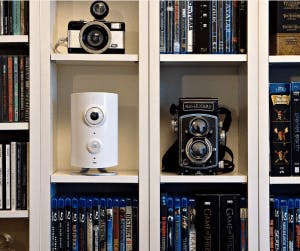
Piper
As of October 2017, Piper is no longer selling Piper Cameras.
The Piper NV is first and foremost a camera. It offers night vision and a wide-angle view so you can use one camera to monitor a large space. Through the mobile app, you can stream live footage of your home or even use two-way audio to communicate with others. If Piper detects motion or sound, it will notify you via text, push notification, email, or phone call. In fact, you can even use all four methods at the same time.
Last year, the Piper nv was our top pick for a camera-based approach as it can integrate with specific Z-Wave devices like door/window sensors, smart bulbs, smart switches, and a water sensor. It also has its own IFTTT channel. However, since Piper was acquired by iControl and subsequently Comcast Cable, the company has done very little to improve the hardware which was already somewhat glitchy. At this point in time, there are better options.
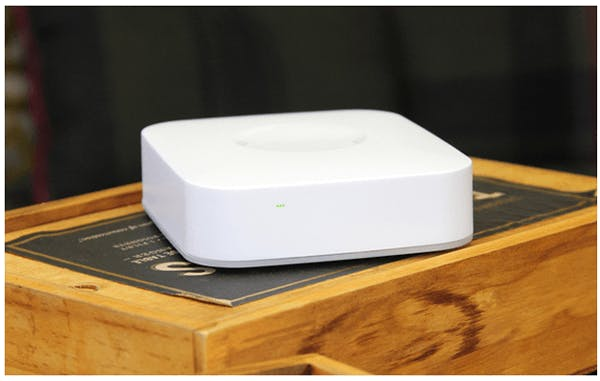
SmartThings
SmartThings was also a past nominee. However, it requires a great deal of effort to get the system to function as a home security system. While it offers wonderful creativity, it will require more effort than the current top picks. Also, the app remains difficult to navigate, though they are migrating users to a newer app called ‘SmartThings Connect’ which has potential.
The V2 hub supports battery backup and allows devices to work locally as well as in the cloud. It also has a feature called “Smart Home Monitor.” From this one screen, you can arm your system, disarm it, check your system status, and even check the status of specific sensors. SmartThings can also connect to other devices, like Amazon Echo for voice control and web-based products or applications through IFTTT. You can even add professional monitoring for $19.99 per month through Scout’s (Yes, Scout’s) professional monitoring service.
The newest SmartThings hub, V3, lacks battery backup but offers wireless connectivity.
Wink Lookout
I apologize to all the Wink fans out there, but to call Wink Lookout a security system is a stretch. Lookout is really just a great name for a kit that includes a Wink smart home hub and a few security oriented sensors. You can’t arm and disarm the system. Instead, you turn alerts on and off. As you can’t disarm it, it can’t do things that a normal self-monitored system can do like trigger a camera to record or trigger the siren. Read our review here.
Tabs
Tabs is a sensor-based security system with some really unique features. For one, it uses LoRaWAN, which is a low-power yet long-range signal. A single hub can control sensors up to a mile away. For example, if you live on a farm, you could potentially use Tabs to protect your home and add sensors in your barn or other outbuildings. Two, in addition to traditional security devices, they sell location-based devices like their Wristband Locator and Object Locator. Our only concern with Tabs is that they are a new company entering a heavily crowded market. We hope they succeed, but success is not a guarantee. And if they don’t? Where does that leave their current user base?
DISCLAIMER: We purchased the iSmart camera, Piper, SimpliSafe, Scout, Ring Alarm, Nest Secure, and everything SmartThings on our own, but the iSmartAlarm system, abode system, and Arlo cameras were given to us for testing. This did not impact our opinion, but we thought you should know.
Self-Monitored Security Systems FAQ
What is a self-monitored home security system?
A self-monitored security system detects security threats and alerts its users and their emergency contacts in the event of an emergency.
What is the key advantage of self-monitored home security systems?
Without monthly monitoring fees, self-monitored systems usually cost less long-term than professionally monitored systems.
What is the biggest disadvantages of self-monitored home security systems?
In case of emergency, only you and your emergency contacts can call for help. If you're incapacitated, the risk of not getting help in time is higher.
How much does a self-monitored home security system cost?
Typically, self-monitored security systems cost around $300, while optional features like cellular backup can be added for less than $10 a month.

